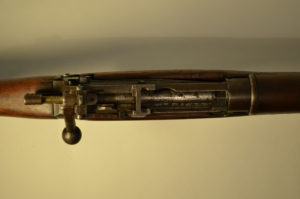Enfield No. 4 Mk. 1


Length: approximately 44 inches
Barrel Length: approximately 25 inches
Caliber: .303
The No. 4 Mk. 1 Enfield rifle was adopted by the United Kingdom in 1941. It is essentially an updated N0. 1 Mk. 3. The No. 4 Mk. 1* is functionally the same as the Mk.1, but various changes were made in the design to make the manufacturing process faster. It retains the 10 round box detachable magazine, however the largest change to the rifle was the addition of a rear aperture sight. The rear aperture is calibrated for 300 meters and flips up to become a ladder sight or another aperture sight calibrated for 600 meters depending on the model. Barrels with two, three, four, five, and six groove rifling were produced.
The bolt heads are marked 0, 1, 2, or 3. This indicates the length of the bolt head with the larger numbers being the longer bolt heads. The longer bolt heads are worth significantly more than the shorter ones and are considerably harder to find.
Commercially, in the United States, these rifles have not been widely available for some time, although nice unsporterized examples can still be found. An average example runs about $375 in very good condition at the time of this writing.
The rifle pictured here is a No. 4 Mk. 1* imported by Century International Arms.
Factory Codes:
ROF (F)- Royal Ordinance Factory, Fazakerley, UK
FY- Royal Ordinance Factory, Fazakerley, UK
(F)- Royal Ordinance Factory, Fazakerley, UK
UF- Royal Ordinance Factory, Fazakerley, UK
ROFM-Royal Ordinance Factory, Maltby, UK
RM- Royal Ordinance Factory, Maltby, UK
M- Royal Ordinance Factory, Maltby, UK
M47C- BSA Co., Shirley, UK
PS- BSA Co., Shirley, UK
S- Savage Arms, Chicopee Falls, MA, USA
Long Branch- Small Arms Ltd., Long Branch, Ontario, Canada
P.O.F.- Pakistan Ordnance Factory, Wah, Pakistan
Many minor variations in parts are present across the different manufacturers and for the different years that the rifles were produced. Most of the parts are interchangeable, the only major difference is usually the factory marking, if it is present. Following World War II, Fazakerley was the only factory that continued manufacturing the Enfield No. 4 Mk. 1 for the British military. Fazakerley also continued to produce the rifle for foreign contracts after the war.
The stocks of British manufactured examples are typically a naturally seasoned English walnut that has a moderately dark brown color and has a tight, straight grain. Beechwood was used on some of the later war specimens and was extensively used on the rifles that were refurbished in the factories. For the rifles produced in North America, American black walnut was consistently used, with birch used as a substitute when walnut was not available.
The metal components of the early examples were oil blackened, making a durable dull black finish. Later in World War II, a hot black oxidizing process was substituted. A few were parkerized at the Long Branch factory later in the war, but these examples are few and far between. When these rifles were refurbished in the factory, they were given a second black oxidizing or they were painted with a matte or semigloss black paint in the spots where the original finish had worn off.
If you liked this information and want to learn more, this volume is an excellent resource: